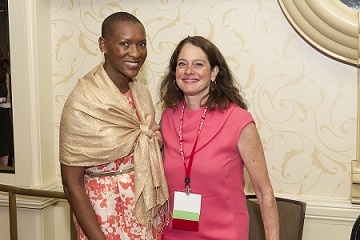How the ADA changed my life: America came together and spoke with one voice
by Katy
Having never been one of those people who knew exactly what they wanted to do when they grew up, I sometimes have to pinch myself at how lucky I have been to have had the enactment of the Americans with Disabilities Act as the beginning of a very rewarding career.
It all started in 1984 with my summer internship on Capitol Hill with an ambitious Congressman from Iowa’s 5th district: Tom Harkin. Fast forward to 1987, when now Senator Harkin became the head of the Senate Subcommittee on the Handicapped (we later changed the name to the Subcommittee on Disability Policy).
Senator Harkin and Senator Lowell Weicker of Connecticut introduced the first version of the Americans with Disabilities Act (ADA) that year. Over the course of the next 3 years, I met and worked side-by-side with disability advocates inside the beltway and across the country. Our common purpose was to get the American public and the Congress to understand that discrimination on the basis of disability took many forms — myth, stereotype, fear — and that this discrimination was counter to our values as Americans and must be rendered illegal.
The Subcommittee conducted many hearings on the ADA. People with disabilities told their own stories about what they wanted out of life, why barriers must be removed and why we, as a country, could do better.
I still remember one woman who was in her late 50s and had breast cancer. She was a tough New York City stock broker who scheduled her chemo visits so they would not interfere with her job. She was fired because her employer didn’t want someone “sick” in their office. I also remember one younger woman who had intellectual disabilities and had a job. When Senator Harkin asked her what she did with her paycheck, she flashed a huge smile and told him, “I bought this beautiful dress.”
In 1988, I married my magnificent husband, Ralph, who also worked on the ADA. He led the efforts of the national civil rights community through the Leadership Conference on Civil Rights (LCCR) and helped to leverage the power of the race, women’s, religious, labor and other members of LCCR to join in the campaign to enact the ADA with the disability community because disability rights are civil rights.
The story of the ADA is the story of America coming together on many different levels. Disability organizations and advocates tossed aside parochial agendas and advanced the ADA with one voice. Civil rights leaders joined disability rights leaders — their cause was our cause. Democrats and Republicans worked together as parents, siblings, and neighbors of people with disabilities. Congress and the White House together made the ADA the law of the land.
I hope that all of us can take a page from the ADA handbook about the value of working together to advance a common goal. The past 25 years of the ADA prove this approach is good for all.
Learn more about ADA history, and how Easter Seals was involved, at easterseals.com/ADA.







